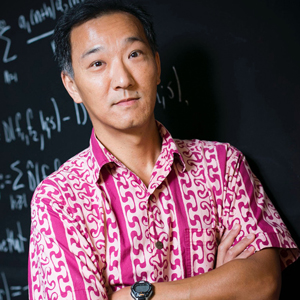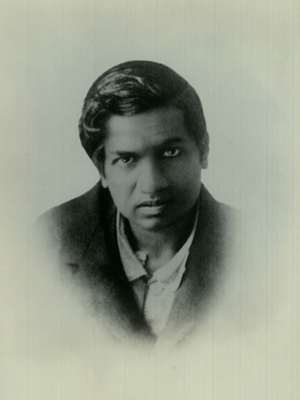Srinivasa Ramanujan was a mathematician born and raised in Madras, India. He grew up impoverished, and didn’t have access to a traditional education, but he was gifted in mathematics. He was accepted into university twice, but both times flunked out because of his inability to focus on anything other than math. He had an arranged marriage but couldn’t provide for his wife. He sent his work off to mathematicians in England, where famous professor G. H. Hardy decided to take a chance on Ramanujan and brought him to Trinity College to work with him. That decision changed the trajectory of each of their lives as well as the field of mathematics.
Why does Ramanujan matter?
That’s a question to be answered by Ken Ono, an associate producer on “The Man Who Knew Infinity,” a biopic about Ramanujan’s life. Ono, himself an accomplished mathematician, is also a professor, a father, a former professional triathlete and most recently an actor in a Super Bowl commercial.

Ono also knows a lot about the life and work of Ramanujan. “He struggled with racism and was a two-time college dropout from a very humble, poor background who somehow assembled in his notebooks formulas that people are still trying to figure out today,” Ono said. “Ramanujan should be remembered as an iconic figure whose ideas, the source of his ideas, defy any natural explanation.”
However, as Ono emphasizes, “Ramanujan matters for many reasons, it’s not just the science. The story between two very different people mattered. Hardy was an atheist, he was gay, he was English, he was a famous professor. Ramanujan was a college dropout, he was a devout Hindu, he was Indian. What those two men were able to achieve together, we still talk about today.” The impacts of Ramanujan's work have been immense. After his death, a notebook of his was discovered full of formulas that many mathematicians are still trying to decipher, including formulas that have helped scientists understand the behaviors of black holes and ideas that power the internet.
“If there’s anything we should have learned over the past three years, there are global challenges that mankind faces," Ono said. "What does that have to do with Ramanujan? His is a story of international scientific cooperation, where people from different countries come together to do something they would have otherwise been unable to do.”
“It gave me hope that maybe mathematics isn’t the stuff of tests, it isn’t about memorizing figures quickly. It had to be something deeper.
Ono’s connection to Ramanujan
Ramanujan holds importance in Ono’s personal life as well. Ono’s parents were adamant that he be a good student. His father was a mathematics professor at Johns Hopkins University. Ono was good at math from a young age, and his parents raised him with the expectation that he become a mathematician. He felt pigeonholed and began to hate the subject.
“The last thing I wanted to be was anything that my parents thought [I ought to be],” Ono said. “In tenth grade, a letter came to the house.” It was a letter to Ono’s father from Ramanujan’s wife. The letter thanked Ono's father for making a small contribution for the commission of a sculpture in memory of Ramanujan. “It was April of 1984 when my dad told me about some Indian guy who died 60 years earlier, who left behind notebooks that mathematicians like himself are still studying today.”
“This guy, no one understood him. His formulas came from a Hindu god, and he was a two-time college dropout. But even my career as a professor at Johns Hopkins is empowered by this guy,” Ono remembers his dad telling him.
“What did I hear? I heard, ‘two-time college dropout’. I heard right there, you don’t have to have perfect SAT scores or perfect grades to become something in the eyes of my parents, and that was the first time I had ever heard them say anything along those lines,” Ono said. “It gave me hope that maybe mathematics isn’t the stuff of tests, it isn’t about memorizing figures quickly. It had to be something deeper. That’s the first time I heard about Ramanujan, and that’s why he matters to me.”
Ono has since travelled to Madras several times to see the place where Ramanujan’s genius shone through the barriers of racism and poverty.
Ono’s journey to associate producer
Matthew Brown, the director and original screenwriter of the film, decided to make the movie after receiving a copy of the book “The Man Who Knew Infinity” when his brother was in the hospital with cancer. As Brown’s brother recovered from cancer, Brown felt the story of Ramanujan had inspired him when he needed hope. He decided to turn the book into a film.
“I was brought on as they were about to begin shooting,” Ono said. The producers needed someone who could determine which formulas were appropriate to write on the blackboards in the movie. After an hour-long Skype call, the producers asked Ono to come to the film set to help the art department with reproduction of documents. After a week on set, Brown asked Ono to stay through the rehearsals with the actors. Ono kept getting promoted, until he was working with Dev Patel (who played Ramanujan) and Jeremy Irons (who played Hardy) directly, giving lectures and acting as Hardy to help Irons get the feeling for a role as a professor. Ono eventually became associate producer a month after he first heard about the film. When the movie was finished, he was able to tour the film circuit, speaking in front of crowds of famous actors and actresses, and he even met Anna Kendrick. "My daughter is not going to believe that Anna Kendrick wants to talk to me," Ono remembers thinking.
Being a part of the filmmaking process isn’t as simple as giving mathematics lectures and traveling the world, though. Ono had to make some important decisions that shifted the direction of the movie.

“First there’s the challenge of what to emphasize. Ramanujan left behind over 6,000 formulas. Then there’s the challenge of how you’re going to explain to anyone that a formula is important. There are very few formulas that the general person knows. Instead of dwelling on the importance of individual formulas, we wanted to talk about what some of these formulas solved.” One of those big mysteries was partitions, which Hardy's character explains in the movie.
“We chose the mathematics of partitions because it could be easily and visibly displayed on screen. All you need to know is how to add and count,” Ono said.
After the movie
Ono’s career has taken many turns since the start of his involvement with the film. Most recently, he was in a Super Bowl commercial leading up to the Big Game, in which he got to talk about his passion for science in an ad for beer.
“I’d spoken out various times about the need to restore value in science and education, and the commercial producers said that’s what they want to do. They want to get a real-life mathematician to underscore that right now we need to restore faith in science, and then make a joke out of it by saying, ‘And here’s one situation where we need that expertise.’ I got to emphasize something that I really believe in.”
Ono’s triathlon days are over due to an injury, but he said maintaining his youthfulness helps motivate him.
“If there’s one principle that I’ve used that’s helped me, it’s that if I find something that looks interesting that I haven’t thought about before, maybe it’s worth a good look. Who doesn’t like learning something new? If you go about your day looking for something that inspires wonder in you, then you never have to go to work.”
Ken Ono’s Discover Science lecture will be held on March 10 at 7 p.m. in the Redfield Auditorium of the Davidson Mathematics and Science Center. Prior to the lecture, a screening of “The Man Who Knew Infinity” will be available at the Joe Crowley Student Union Theater at 4 p.m. Both events are free and open to the public, and registration is required. Free parking is available in the Brian Whalen Parking Garage.
Ono will also be featured on the College of Science’s Discover Science podcast. He’ll be interviewed by a doctoral student studying number theory and a master's student in the Reynolds School of Journalism Hitchcock Project for Visualizing Science.
The Discover Science Lecture Series was started in 2010 with the goal of bringing accomplished scientists from all over to the University. Past speakers have included the likes of Bill Nye the Science Guy and Neil deGrasse Tyson. This year, the series kicked off with University alumnus Doug Smith, the project lead for the Wolf Restoration Project in Yellowstone National Park. The next speaker will be astronaut and geologist Harrison Schmitt, the last living person to walk on the Moon. Closing out the season is leading developer of the Moderna COVID-19 mRNA vaccine and healthcare activist, Kizzmekia Corbett. Corbett’s lecture will serve as this season’s Glick Lecture.















